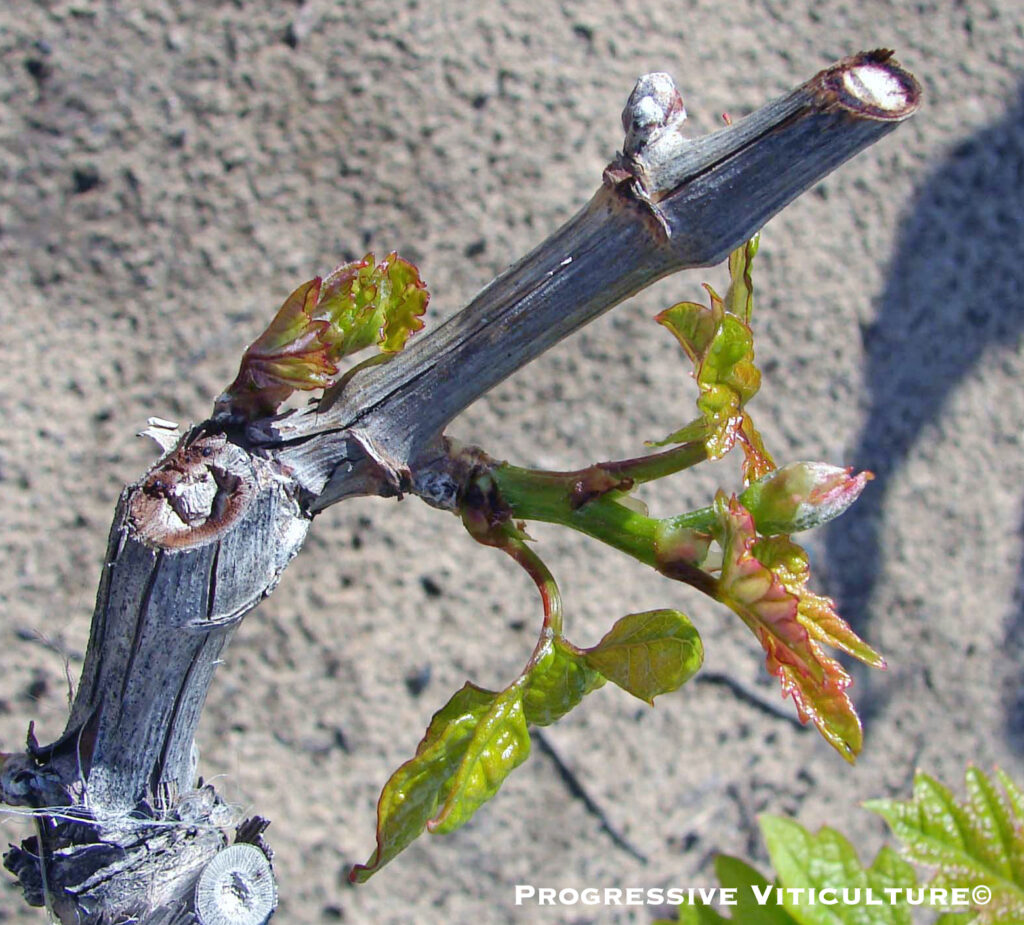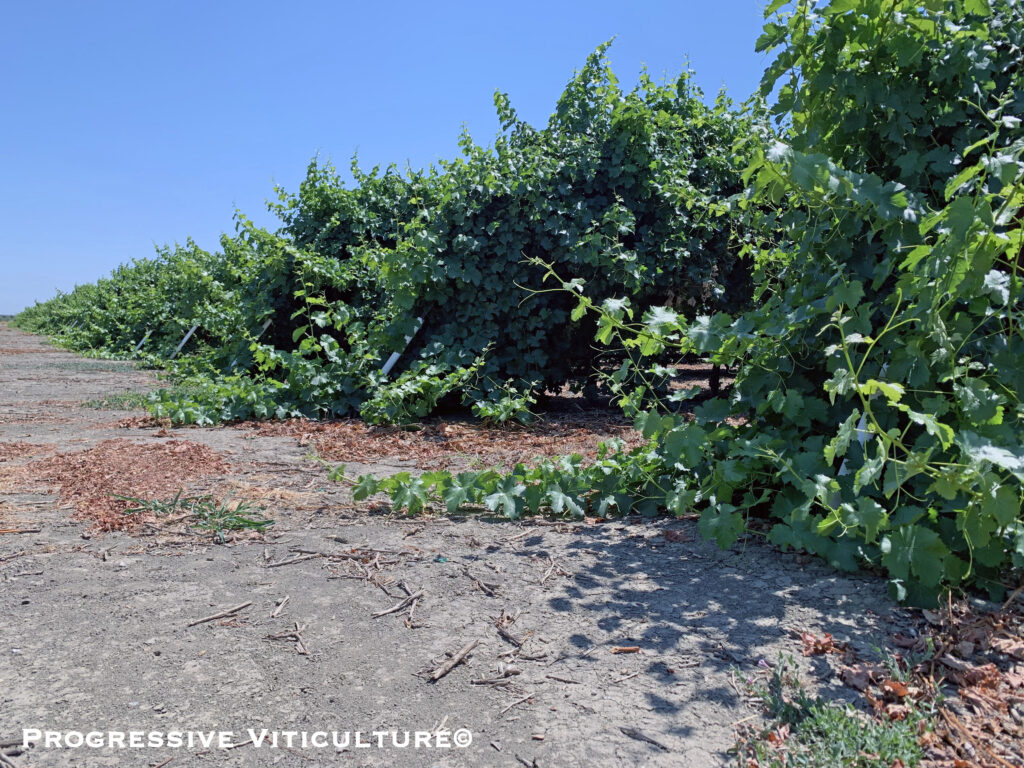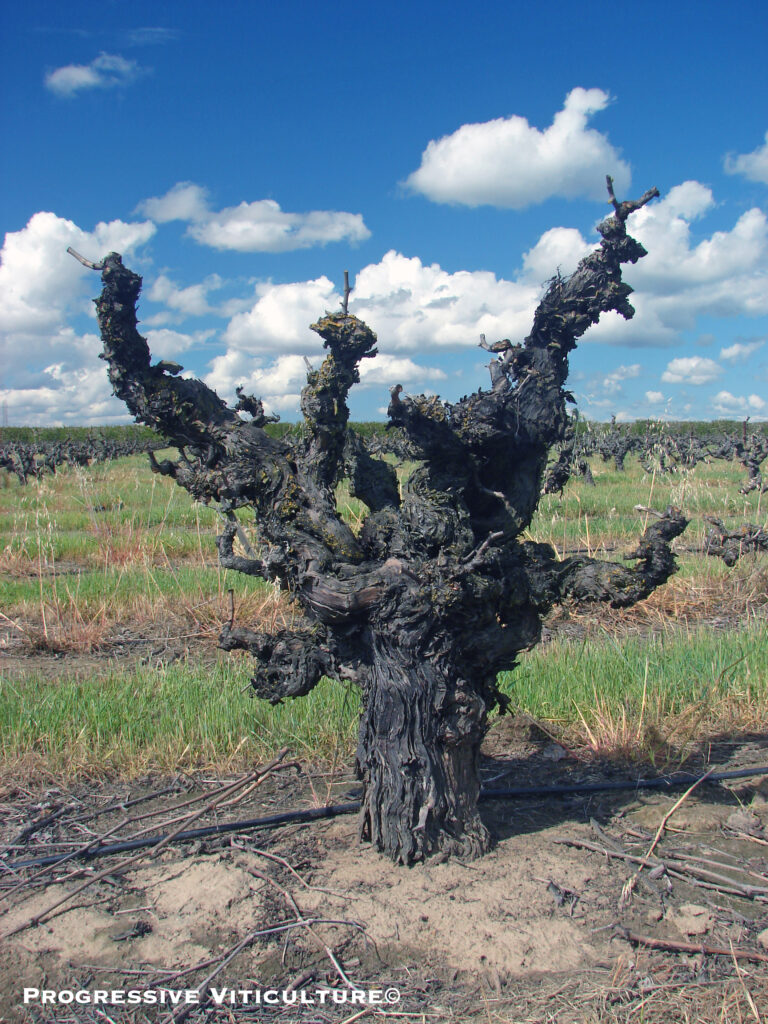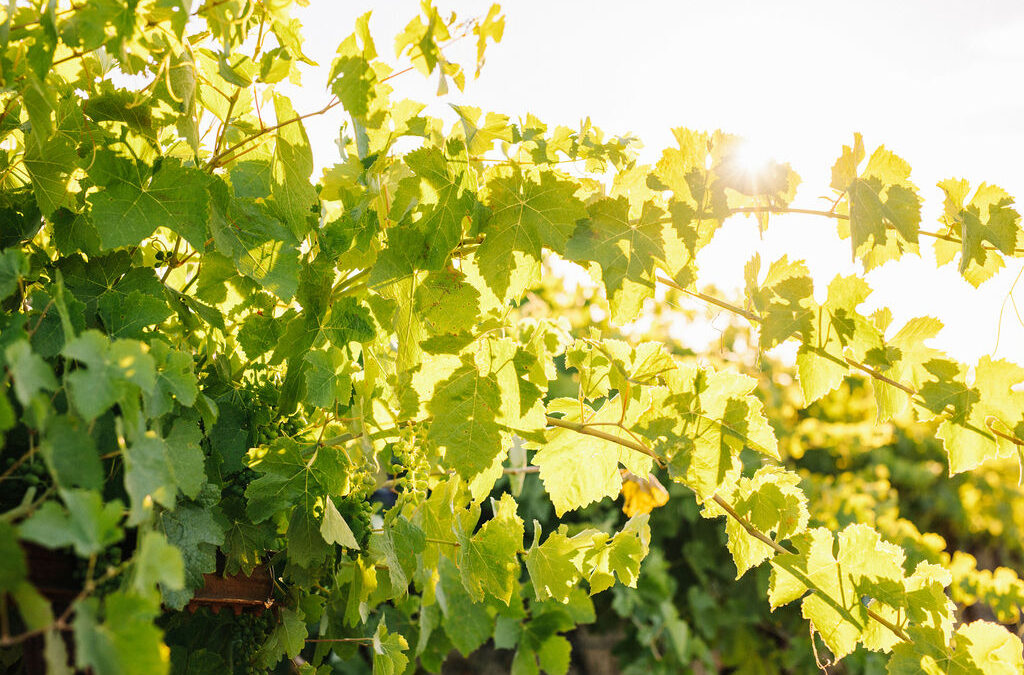MONDAY, MARCH 1, 2021. BY STAN GRANT, VITICULTURIST.
Growers of annual crops have it comparatively easy. If things don’t work out well one season, in the next season they have an entirely new set of plants and a new opportunity to optimize production. In contrast, growers of perennial crops, like grapevines, have to work with carry-over effects from previous years and can achieve optimum production only through sustained diligence. Still, in spite of its central importance, it is all too easy to forget about the perennial nature of grapevines amidst the details of daily management duties and other vineyard concerns.

Figure 1. Three early-season developmental stages on the same spur: wooly bud (E-L stage 03, upper bud), budbreak (E-L stage 05, basal bud), and two to three leaves unfolded (E-L stage 09, lower bud). (Progressive Viticulture©)
There are two elements of the perennial nature of grapevines that are especially important to vineyard management: seasonal grapevine development and the woody vine framework. They are the topics of this article.
Grapevine Seasonality
The seasonal sequence of grapevine growth and development events, sometimes called phenology, begins each year after a period of dormancy (Figure 1). After buds break and shoots emerge, the vine experiences a period of shoot growth and canopy development, and after bloom, a period of fruit growth and berry development. During these times, certain developmental milestones are clearly visible, relatively short in duration, and easy to delineate. These include budbreak, flowers clearly visible, early bloom, fruit set, the beginning of cluster closure, the beginning of ripening, and others (Table 1).
Developmental milestones are of central importance to efficient and profitable vineyard management, primarily because they serve as a calendar for the effective timing of certain operations and input applications. The application of zinc, boron, phosphorus, and molybdenum fertilizers to vine foliage immediately before or early in bloom to promote maximum fruit set is a well-known example. Another example involves regulated deficit irrigation schedules, where moderate water stress between fruit set and the beginning of ripening (veraison) is of greater fruit quality benefit than later water stress.

Figure 2. Late season unrestricted grapevine shoot growth (Sauvignon blanc). (Progressive Viticulture©)
While most aspects of seasonal grapevine development have a definite endpoint, shoot development has the potential to continue without interruption until the first killing frosts of autumn so long as temperatures are favorable and ample soil resources are available (Figure 2). The potentially indeterminate growth habit of vine shoots is fairly uncommon among perennial crop plants (most tree shoots set a terminal bud), but it is a central feature of grapevines. This trait, which benefits climbing grapevines in the wild, can easily hinder winegrape production. Accordingly, the failure of vineyard managers to limit the supply of available resources, particularly soil moisture and nitrogen, allows shoots to continue growing at the expense of fruit yield, grape quality, cane wood development, and winter hardiness.
Another feature of grapevine phenology is the initial development of next season’s flower clusters during the early part of the current season. In effect, grape growers simultaneously manage two crops every year. Of particular importance for cluster initiation is the maintenance of moderate soil moisture and adequate mineral nutrient availability through bloom, as well as practices leading to fruit zone exposure to sunlight, normal rates of shoot growth and leaf area development, and timely cane wood ripening. Moderate root zone moisture post-harvest and during dormancy also contributes to optimal bud fruitfulness.
The Woody Grapevine Framework

Figure 3. A head-trained vine with a thick trunk and arms, and correspondingly, a comparatively high capacity for growth. (Progressive Viticulture©)
The combination annual regeneration of shoots and roots, as described above, and durable woody tissues allow grapevines to survive for many years and over many cold winters. Woody tissues form the perennial grapevine structure, which includes thicker roots (≥ 1/4 inch diameter), the trunk, and depending on training system, arms or cordons (Figure 3).
In addition to aiding vine survival, woody tissues serve other important practical functions in vineyards. First, in a well-designed vineyard, the configuration of the above-ground woody framework, as formed through training, will facilitate vineyard operations, encourage uniform and balanced growth with minimum inputs, and promote fruit exposure to dappled sunlight with minimum foliage manipulation.
Secondly, woody tissues serve as reservoirs of stored carbohydrates and mineral nutrients that are crucial to consistent annual yields of ripe fruit. Research, in which vines with longer trunks produced larger fruit yields and enhanced fruit maturity, underscores the importance of woody tissues as sources of stored nutrients. In other research, reductions in woody tissues through root pruning and the substitution of canes for cordons reduced fruit yields.
Vineyard management has a significant influence on the size of woody vine organs and the volume of stored reserves through its effects on canopy development, crop load, vine health, and post-harvest soil conditions. For example, grapevines undersupplied with either water, fertilizer, or certain pest control measures produce a limited number of leaves and new roots, and of those produced, leaves and roots are smaller than normal. As a result, limited carbohydrates are synthesized and the uptake of soil resources is inhibited. Consequently, the radial expansion (secondary growth) of woody vine organs is restricted and reserve storage in woody tissues is curtailed.
The following growing season, limited reserves inhibit the emergence and growth of shoots. Without assertive management intervention, the vines will fail to reach the full canopy, become overcropped, and decline further (Figure 4). Severe or reoccurring decline may ultimately result in vine death.
Given this possible scenario, it is easy to understand how full canopy development (14 to 20 nodes per shoot) shortly after the fruit set has become a hallmark of a well-managed vineyard. The post-harvest period is another opportunity for vineyard managers to promote reserve storage. To make the most of this opportunity, maintain a continuous supply of moderate moisture and an adequate supply of mineral nutrients in the soil that sustains root and leaf activities.
In Summary
Due to their perennial nature, grapevines have the potential for long lives. Their actual lifetimes depend on environmental conditions, available resources, and management actions. In the short term, these three factors determine canopy development, fruit yield, and degree of ripening. Stressful environmental conditions, resource limitations, and management neglect can carry over into subsequent years, sometimes to the long-term detriment of vines.
A version of this article was originally published in the Mid Valley Agricultural Services April 2005 newsletter and was updated for this blog post.
Further Reading
Bains, KS, Bindra, AS, and Bal, JS. Seasonal changes in carbohydrate and mineral composition of over vigorous and devitalized Anabe-Shahi grapevines in relation to unfruitfulness. Vitis. 20, 311-319. 1981.
Coombe, BG. Phenology. In Viticulture volume 1: practices. Coombe, BG, Dry, PR (ed.). Winetitles, Adelaide. pp.139-153. 1988.
Eifert, J, and Eifert, A. Maximum of starch during spring in the woody plant (Vitis riparia Michx). Nature (London). 199, 825-826. 1963.
Goffinet, MC, and Pratt, C. Grapevine structure and growth stages. In Wilcox, WF, Gubler, WD, and Uyemoto, JK (ed.). Compendium of Grape Diseases. 2nd ed. APS Press, St. Paul, MN. pp. 5-15. 2015.
Keller, M. The science of grapevines. Academic Press, Burlington, MA. 2010.
Koblet, W, and Perret, P. The role of old vine wood on yield and quality of grapes. In University of California, Davis grape and wine centennial symposium proceedings. Webb, AD (ed.). pp 164-169. University of California Press, Berkeley. 1982.
Kramer, PJ, and Kozlowski, TT. Physiology of woody plants. Academic Press, San Diego. 1979.
Mullins, MG, Bouquet, A, and Williams, LE. Biology of the grapevine. Cambridge University Press. 1992.
Salisbury, FB, and Ross, CW. Plant physiology. Wadworth Publishing Company, Belmont, California. 1978.
Have something interesting to say? Consider writing a guest blog article!
To subscribe to the Coffee Shop Blog, send an email to stephanie@lodiwine.com with the subject “blog subscribe.”
To join the Lodi Growers email list, send an email to stephanie@lodiwine.com with the subject “grower email subscribe.”
To receive Lodi Grower news and event promotions by mail, send your contact information to stephanie@lodiwine.com or call 209.367.4727.
For more information on the wines of Lodi, visit the Lodi Winegrape Commission’s consumer website, lodiwine.com.




